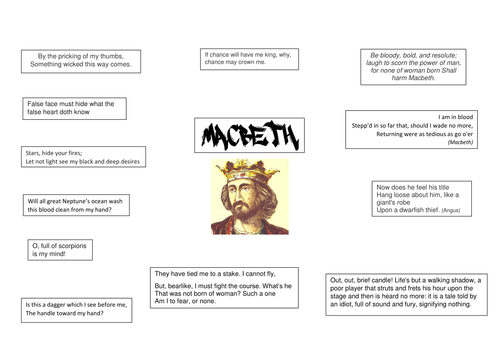


This lesson asks students to explore the character of Macbeth across the play by commenting on the significance of quotes (A01,2, 3). It refers to the success criteria of the AQA English Literature GCSE but can be adapted for your course.
The lesson starts by asking students to summarize him as a character using adjectives and then to narrow down his appearances into 5 'top' moments in order to remind them of the wider picture. Slides reminding them of these follow as well as a list of links to online videos of some of these key scenes. Since there's not always time in lessons, perhaps they can be given to students to watch as homework.
Attached is a 'quote explosion' sheet of quotes that he says or that others say about him. Students can stick these across a page in their exercise book and annotate what they show about him as a character and pick out any imagery (symbolism, metaphor, antithesis, apostrophe etc). It could also be blown up to A3 size (great for displays!) A copy of this is on a slide in the Powerpoint for the teacher / students to also annotate on the board when the class gathers their ideas together.
Next there is a list of 'challenge/extension' tasks which explore Macbeth as a tragic hero. A list of qualities expected in tragic protagonists is listed and students can discuss how Shakespeare used this formula to enrich the plot.
The lesson ends with a chance for students to write independent essay paragraphs with AQA's exam success criteria but this can be adapted for your course. There are 3 options on how to approach essay writing: 'layers of meaning', PEA, or the 'reading ladder' which follow the same idea. There is then an opportunity to self or peer assess according to the key skills.
As with all my lessons, there are 'Talk for Writing' activities and Challenge tasks for more able students.
Please see my other lessons on Macbeth which explain his state of mind in more detail.
The lesson starts by asking students to summarize him as a character using adjectives and then to narrow down his appearances into 5 'top' moments in order to remind them of the wider picture. Slides reminding them of these follow as well as a list of links to online videos of some of these key scenes. Since there's not always time in lessons, perhaps they can be given to students to watch as homework.
Attached is a 'quote explosion' sheet of quotes that he says or that others say about him. Students can stick these across a page in their exercise book and annotate what they show about him as a character and pick out any imagery (symbolism, metaphor, antithesis, apostrophe etc). It could also be blown up to A3 size (great for displays!) A copy of this is on a slide in the Powerpoint for the teacher / students to also annotate on the board when the class gathers their ideas together.
Next there is a list of 'challenge/extension' tasks which explore Macbeth as a tragic hero. A list of qualities expected in tragic protagonists is listed and students can discuss how Shakespeare used this formula to enrich the plot.
The lesson ends with a chance for students to write independent essay paragraphs with AQA's exam success criteria but this can be adapted for your course. There are 3 options on how to approach essay writing: 'layers of meaning', PEA, or the 'reading ladder' which follow the same idea. There is then an opportunity to self or peer assess according to the key skills.
As with all my lessons, there are 'Talk for Writing' activities and Challenge tasks for more able students.
Please see my other lessons on Macbeth which explain his state of mind in more detail.
Something went wrong, please try again later.
This resource hasn't been reviewed yet
To ensure quality for our reviews, only customers who have purchased this resource can review it
Report this resourceto let us know if it violates our terms and conditions.
Our customer service team will review your report and will be in touch.
£3.00